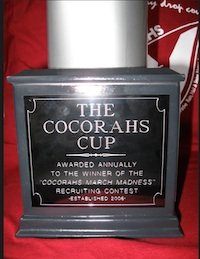Do you ever wonder how much rain a thunderstorm brought to your backyard, or how deep the snow was after a winter storm? If so, then you could be a great addition to a growing national network of amateur observers! CoCoRaHS — or the Community Collaborative Rain, Hail and Snow network — is a collection of volunteers who observe and report precipitation measurements each day. These reports help supplement existing observations from local weather stations and fill in gaps where there are no nearby stations.
CoCoRaHS came about as a result of a devastating flash flood that hit Fort Collins, Colorado, in July 1997. A local severe thunderstorm dumped over a foot of rain in several hours while other portions of the city had only modest rainfall. The ensuing flood caught many by surprise and caused $200 million in damages. CoCoRaHS was born in 1998 with the intent of doing a better job of mapping and reporting intense storms. As more volunteers participated, rain, hail, and snow maps were produced for every storm showing fascinating local patterns that were of great interest to scientists and the public.
North Carolina established the CoCoRaHS program in 2007, and by 2010, the CoCoRaHS network had reached all 50 states with about 17,500 observations being reported each day. Through CoCoRaHS, thousands of volunteers, young and old, document the size, intensity, duration and patterns of rain, hail and snow by taking simple measurements in their own backyards.

Every year, a friendly recruiting contest called CoCoRaHS March Madness takes place between all 50 states to see who can recruit the most new volunteers during the 31 days of March. North Carolina has won the contest for the past two years, taking home the “CoCoRaHS Cup”!
How can you help us take home the cup again this year? Become a CoCoRaHS observer! Go to the CoCoRaHS website and click on the “Join CoCoRaHS” emblem on the upper right side of the main website. After registering, take the simple online training, order your 4-inch rain gauge and start reporting! Observations are immediately available on maps and reports for the public to view. The process takes only five minutes a day, but the impact to the community is tenfold.
By providing high quality, accurate measurements, the observers are able to supplement existing networks and provide useful data to scientists, resource managers, decision makers and other users. An additional benefit of the program to the National Weather Service is the ability to receive timely reports of significant weather (hail, intense rainfall, localized flooding) from CoCoRaHS observers that can assist forecasters in issuing and verifying warnings for severe thunderstorms.
Be sure to check the CoCoRaHS March Madness weekly standings to see how North Carolina is doing this year!
